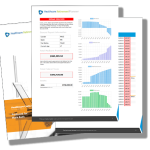When it comes to Life Insurance and which type to choose it can be difficult to make a decision between Whole Life vs Universal Life Insurance. Both options offer safety nets for your loved ones’ futures but choosing one can be quite a challenge.
You might wonder: Which offers better coverage flexibility? Can I adjust premium payments if my income fluctuates? How does each policy grow cash value over time?
This post is your flashlight in this decision-making tunnel for Whole Life vs Universal Life Insurance. We’ll dive deep into Whole Life’s stability with its fixed premiums and guaranteed death benefit. Then we’ll uncover Universal Life’s unique selling point – its flexible long-term protection that allows adjustments as per financial circumstances.
We’re not just dishing out facts here. We aim to aid you in forming decisions that are adapted to your individual ambitions and requirements.
Whole Life Insurance Policy: A Deep Dive and guidance
Whole life insurance, a form of permanent life insurance, stands out for its stability and lifetime protection. Let’s look at why this might be your safety net in the financial world.
The Stability of Whole Life Insurance
You can think of whole life as a sturdy, reliable house that shields you from economic storms. It offers fixed premiums – it’s like having locked-in rent. These won’t rise even if inflation soars or health declines. With these consistent premium payments, budgeting becomes more manageable.
This type of policy also includes a guaranteed death benefit. Imagine leaving behind not just memories but also financial security for loved ones – no decrease over time. You pay the same amount; they get peace without worrying about future uncertainties.
Cash Value Accumulation in Whole Life Policies
Apart from acting as an insurance plan, Whole Life policies double up as savings accounts too. Every premium payment builds cash value over time – much like how every brick strengthens your house.
Your money grows on a tax-deferred basis (Yes, Uncle Sam has to wait.). This growing cash surrender value could act as an emergency fund or help fulfill other short-term goals.
Beyond these perks, many Whole Life policies even pay dividends – making them something akin to renting with benefits.
“Think long term when investing in such plans,” says our experienced financial advisor. “The growth may seem slow initially but remember that Rome wasn’t built overnight.”
| Type Of Policy: | Whole Life Insurance |
|---|---|
| Protection: | Lifetime, guaranteed |
| Premiums: | Fixed, will never rise. |
| Death Benefit: | Certain, no decrease over time. |
This financial tool isn’t just insurance, it’s a pledge to what lies ahead. Yet, as with all investment choices,
Key Takeaway:
Whole Life Insurance is like a sturdy house, protecting you from financial storms with fixed premiums and guaranteed death benefits. It’s more than just an insurance plan; it doubles as a savings account, building cash value over time. This slow-and-steady growth can be your safety net in the financial world.
Universal Life Insurance Uncovered
When you’re looking for a insurance policy, one option that may come up is Universal Life Insurance. What does universal life entail?
The heart of Universal Life lies in its flexibility. Unlike other forms of permanent life insurance like whole or term, universal doesn’t tie you down to fixed premium payments. Instead, it lets you adjust your premiums and the death benefit as your needs change over time.
Flexible Long-Term Protection with No Fixed Premiums
This kind of long-term protection can be a great asset if your financial situation changes from one year to the next. If money’s tight one year, decrease your premiums. When things look better next year? Bump them back up again. It’s all about giving yourself coverage flexibility while keeping an eye on growth potential.
No two lives are alike – so why should our policies be? With universal life, they don’t have to be.
Premium Adjustments and Policy Changes: All in Your Hands
With Traditional Whole or Term policies, changes aren’t easy – often requiring a completely new contract. Not so with Universal. Need more coverage because the family is growing? You got it. Want less since the kids finally moved out (about time)? That works too.
Your financial safety net shouldn’t feel like handcuffs – that’s where Universal Life shines bright.
Table Of Contents:
- Whole Life Insurance: A Deep Dive
- Universal Life Insurance Uncovered
- Comparing Death Benefits in Whole Life vs Universal Life
- The Role of Cash Value in Whole Life and Universal Life Policies
- Risk and Growth Potential in Universal Life Policies
- Choosing Between Whole Life and Universal Life Insurance
- FAQs in Relation to Whole Life vs Universal Life
The Potential Downside: Death Benefit Isn’t Guaranteed
A guaranteed death benefit isn’t part of this package though; it’s dependent on how well you manage those adjustable premium payments. But hey – we’re adults here making big adult decisions. Just remember: balance is key when choosing universal life. It’s a little bit of risk, but with the potential for a whole lot of reward.
Universal Life insurance can be your trusty sidekick on this crazy ride called life – it’s got your back when you need it and gives you space when you don’t.
In Summary
Craving flexibility in your insurance policy? Universal Life could be your perfect match. Just make sure to consider those premium adjustments and give them some thought.
Key Takeaway:
Universal Life Insurance stands out with its flexibility, allowing you to adjust premiums and death benefits as your life circumstances change. It’s a long-term protection that can adapt to fluctuating incomes, offering more control than traditional policies. Just remember – it involves some risk management since the death benefit isn’t guaranteed.
Comparing Death Benefits in Whole Life vs Universal Life
The choice between whole life and universal, often comes down to your individual needs, goals, and the level of flexibility you prefer. But what about death benefits? How do they stack up against each other?
Guaranteed Death Benefit: A Hallmark of Whole Life Insurance
In a world full of uncertainties, Whole Life Insurance offers one solid guarantee – the death benefit. It’s like a safety net that will never break or shrink over time.
No matter when you pass away, as long as your premium payments are up-to-date, your beneficiaries will receive the same amount you agreed upon when signing for the policy. The keyword here is ‘guarantee’. With this type of permanent life policy in place, peace of mind becomes more than just an abstract concept; it’s something tangible.
The Flexibility Factor: Death Benefit under Universal Life Insurance
Moving onto Universal Life Insurance, things get interesting due to its adjustable nature. Unlike its whole counterpart where everything is set from day one, universal policies allow you to adjust premium payments according to how income fluctuates year by year.
This kind of coverage flexibility means that if money gets tight and premiums drop below a certain point for too long – say hello potential policy lapse. So unlike whole life which gives guaranteed death benefits regardless of fluctuations in financial circumstances throughout years lifetime – there’s no such promise with universal coverages.
A Quick Comparison Between Both Policies’ Death Benefits
| Whole Life Insurance | Universal Life Insurance | |
|---|---|---|
| Death Benefit | Guaranteed to never decrease as long as premiums are paid. | No guarantee. Death benefit may reduce if premium payments drop below a certain point. |
| Premium Payments Impact on Policy Lapse Risk and Death Benefit (if not maintained) | No risk of policy lapse or reduced death benefit due to fixed premium payment structure. Premiums remain unaltered over the life of the policy. |
Key Takeaway:
Whole Life Insurance gives you a guaranteed death benefit, acting as an unbreakable safety net for your loved ones. Universal Life Insurance offers more flexibility with adjustable premiums, but it also comes with the risk of potential policy lapse if payments drop too low. The decision between these two largely depends on your personal needs and financial stability.
The Role of Cash Value in Whole Life vs Universal Life Policies
When it comes to life insurance policies, cash value plays a pivotal role. It’s the portion of your policy that grows over time, offering you more than just a safety net for your loved ones.
Cash Value Accumulation: A Closer Look at Whole Life Insurance
A whole life insurance policy has an interesting feature – it builds cash value. This means part of your premium payments goes into creating this cash reserve, which can be accessed during the life of the policy. Over time, as more premiums are paid, this amount continues to grow on a tax-deferred basis.
Whole life policies often come with guaranteed cash values; they let you build wealth while ensuring coverage for lifetime or up to 100 years whichever is earlier. The growth here is based on a formula determined by the insurer and remains unaffected by market fluctuations.
The Dynamic Nature of Cash Value in Universal Life Insurance
Universal policies, however offer variable returns depending upon market performance because these have their roots in money markets unlike whole life policies where earnings are mostly fixed and stable. Premium payment flexibility further adds charm as one may increase or decrease premiums according to income fluctuations throughout different stages in their lives without risking a potential policy lapse due to non-payment.
This kind-of flexible approach lets universal polices work great when you prefer flexibility but remember that while there’s room for higher gains due to its exposure towards equities; losses might occur if investments don’t perform well resulting reduced death benefits.
Whole vs Universal Life: The Cash Value Difference
In comparison, cash value accumulation in whole life insurance is more predictable and stable, but less flexible. It’s like a slow and steady turtle that guarantees to reach the finish line (your financial goals). On the other hand, universal is akin to an agile rabbit – it has high growth potential if conditions are right but also carries higher risk.
So, when picking between these two types of permanent life insurance, you gotta ask yourself: do I want stability or flexibility? Would I rather lock in fixed premiums with surefire returns, or choose to pay my premiums as it suits me?
Key Takeaway:
Cash value plays a crucial role in both whole and universal life insurance. While whole life policies offer guaranteed, steady growth unaffected by market conditions, they lack flexibility. Universal life insurance offers more adaptability with potential for higher returns based on market performance but carries the risk of losses too. The choice boils down to your preference: stability or flexibility?
Risk and Growth Potential in Universal Life Policies
Universal life insurance is like a box of chocolates. You never know what you’re gonna get when it comes to cash value growth options, which can range from low to high risk. The versatility allows policyholders the opportunity for more aggressive investment strategies, but this also opens up the possibility for loss.
The beauty of universal life policies lies in their flexibility – they let you adjust premium payments and death benefits according to your financial situation. But while these adjustments give room for higher returns, they also come with increased risks.
Cash Value Growth Options: The Sweet Spot Between Risk and Reward
Let’s talk about how different types of universal life insurance offer varying levels of cash value growth options. These include indexed universal life insurance, variable universal life insurance, and guaranteed universal life insurance among others.
Indexed Universal Life Insurance (IUL), as one example has its cash values tied directly to an equity index such as S&P 500 or Nasdaq-100 without direct participation in the stock market itself. This means that if markets perform well, so does your policy’s cash value – within limits set by the insurer. On the flip side though if markets don’t do so hot…well I’m sure you see where we’re going here.
Weighing Risks With Variable Universal Life Policies
In contrast, Variable Universal Life Insurance places your money into subaccounts similar to mutual funds chosen by you with potentially unlimited upside but at greater risk because losses are not protected against unlike IULs. This could mean big bucks during good times but make sure you’re buckled in for a bumpy ride when markets aren’t as favorable.
Then there’s Guaranteed Universal Life Insurance, the steady eddy of universal life policies. While it doesn’t provide the potential high returns like its counterparts, it offers stable growth and guaranteed death benefits – provided you pay your premiums. This is more similar to whole life insurance but with flexibility around premium payments and coverage amounts that are absent in whole life policies.
Navigating Risk With A Financial Advisor
Deciding between these types can seem pretty overwhelming, particularly when your income’s not steady.
Key Takeaway:
Universal life insurance offers flexible, growth-focused options like Indexed and Variable policies that link cash value to market performance. But be prepared for risks. For more stability, consider Guaranteed Universal Life Insurance – it’s similar to whole life but with premium and coverage flexibility.
Choosing Between Whole Life and Universal Life Insurance
Both options have unique features that can align with different financial goals and needs.
Your Financial Goals: The Guiding Star
To navigate the sea of choices, your financial objectives serve as the North Star. If you’re looking for stability, whole life insurance offers guaranteed lifetime protection with fixed premiums that won’t rise. This feature makes it an attractive safety net.
On the other hand, if flexibility is paramount because your income fluctuates or you prefer to adjust premium payments when needed, consider universal life insurance. Unlike its counterpart, this policy type allows for premium adjustments based on changing circumstances.
The Death Benefit: A Critical Consideration
A critical component in any discussion about choosing a life policy is the death benefit – a sum paid out upon death. Both types offer a death benefit but only whole life guarantees it will never decrease; making it akin to building a house on solid rock versus shifting sands for those who need certainty in their planning process.
Cash Value Accumulation: An Apples-to-Oranges Comparison
Both types can build cash value over time which functions like squirreling away acorns for winter use – but they do so differently. In general terms, think of whole policies as having slow-and-steady growth while universal ones are more like wild rabbits — offering higher potential gains but also risks.
Note: Always consult with experienced agents or financial advisors before making any decision.
Risk and Growth Potential: A Balancing Act
It’s like walking a tightrope. With whole life, you’re guaranteed cash value growth; it’s safe but slow — akin to taking the scenic route. Universal life policies, however, are more like speedboats offering higher potential returns with varying levels of risk – they can offer exciting rides or capsize in stormy seas.
Picking between whole life and universal life insurance isn’t just about choosing one. It’s more about understanding your own needs.
Key Takeaway:
Choosing between whole life and universal life insurance boils down to your financial goals, risk tolerance, and need for flexibility. Whole life provides steady growth and guaranteed benefits but lacks adaptability. Universal life offers more potential gains with a higher level of risk, alongside premium payment flexibility.
FAQs in Relation to Whole Life vs Universal Life
Which is better whole life or universal life?
The choice between whole and universal life depends on your financial goals. Whole offers stability, while Universal gives flexibility.
What are the disadvantages of universal life insurance?
Universal policies can be riskier as they lack fixed premiums and guaranteed death benefits. The cash value might also fluctuate based on market conditions.
What is the difference between universal life and basic term life?
The key difference lies in their duration – term covers you for a set period whereas Universal provides lifetime coverage with added investment elements.
Streamlining the Medicare Surcharge Calculation Process.
Our Healthcare Retirement Planner software is designed to streamline the retirement planning process for financial professionals. By providing an efficient way to calculate IRMAA costs, our tool helps you save time and focus on other aspects of your clients’ retirement plans.
- Faster calculations: Our software quickly calculates IRMAA costs based on your client’s income and tax filing status, eliminating manual calculations and potential errors.
- User-friendly interface: The intuitive design of our platform makes it easy for financial professionals to input data and generate results with minimal effort.
- Data integration: Seamlessly integrate our calculator into your existing financial planning tools or CRM systems for a more streamlined workflow.
- Easy to Understand Reports: Export reports to easily share with your clients
- Tax and Surcharge Modeling: see how different types of income affects both taxes and your surcharges.
In addition to simplifying the calculation process, using our Healthcare Retirement Planner can also help improve communication between you and your clients. With clear visuals that illustrate how IRMAA costs impact their overall retirement plan, you can effectively convey complex information in an easily digestible format. This enables clients to make informed decisions about their healthcare expenses during retirement while ensuring they are prepared for any potential changes in Medicare premiums due to income fluctuations. To learn more about how our software can benefit both you as a financial professional and your clients’ retirement planning experience, visit the features page. Streamlining retirement planning processes can help financial professionals save time and resources, allowing them to focus on other areas of their clients’ needs. Automated calculation of IRMAA costs is the next step in streamlining this process even further.







